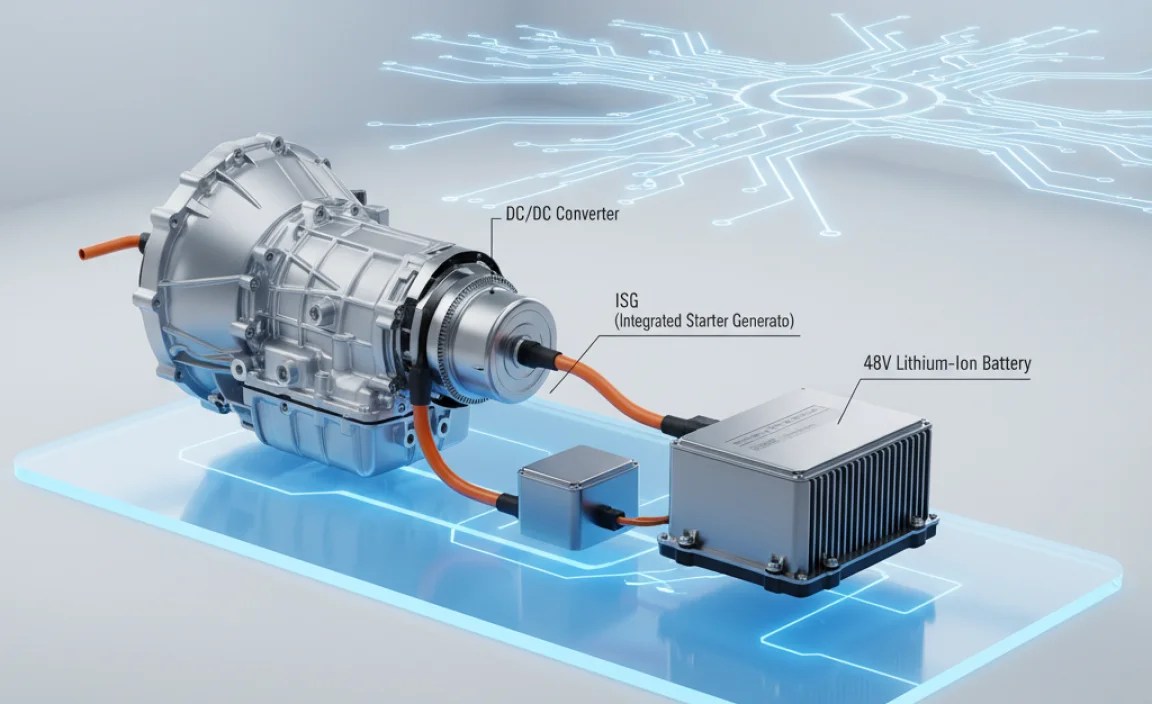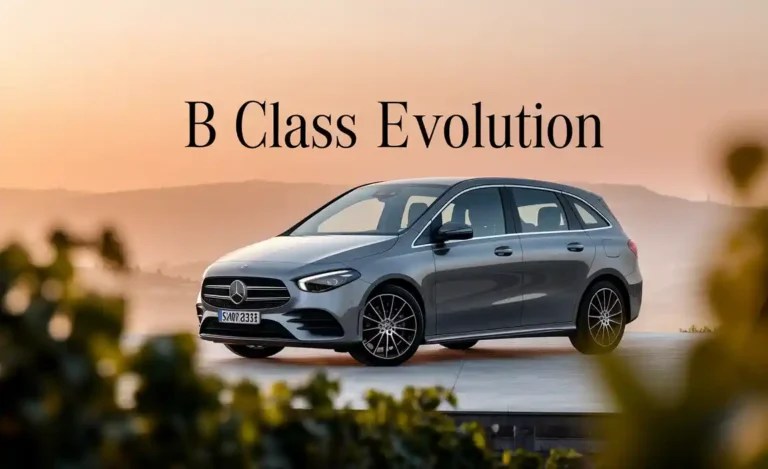Mercedes Mild Hybrid Models: A Beginner’s Guide
Mercedes mild hybrid models use a small electric motor to help the engine, saving fuel and boosting performance. This system makes driving smoother and more efficient without needing to plug in the car. It’s a great way to enjoy Mercedes luxury with a bit more green technology.
Thinking about getting a Mercedes-Benz but not sure what “mild hybrid” means? You’re not alone! It can be confusing with all the new car tech out there. Many drivers are curious about how these systems work and if they’re worth it. This guide will break down everything you need to know about Mercedes mild hybrid models. We’ll cover how they work, the benefits, and which models offer this technology. Get ready to understand your Mercedes better!
What is a Mild Hybrid?

A mild hybrid is a type of hybrid vehicle that uses a small electric motor to assist the gasoline engine. Unlike a full hybrid or plug-in hybrid, a mild hybrid cannot run on electric power alone. Instead, the electric motor provides extra power during acceleration, improves fuel economy, and allows for smoother start-stop operation.
How Does it Work?
The mild hybrid system in Mercedes-Benz vehicles typically includes a 48-volt electrical system and an integrated starter-generator (ISG). Here’s a breakdown of how it works:
- Energy Recuperation: When braking or decelerating, the ISG captures kinetic energy and converts it into electricity. This electricity is stored in a small battery.
- Boost Assistance: During acceleration, the ISG provides an extra boost of power to the engine. This reduces the load on the engine, improving fuel efficiency and performance.
- Start-Stop System: The ISG enables a smoother and faster start-stop operation. When the car comes to a stop, the engine shuts off to save fuel. When you’re ready to go, the ISG quickly and quietly restarts the engine.
- Coasting: At higher speeds, the engine can shut off completely and the car can “coast” using the electric motor, further saving fuel.
Benefits of Mercedes Mild Hybrid Models

There are several advantages to choosing a Mercedes-Benz mild hybrid. These benefits make the driving experience more enjoyable and efficient.
- Improved Fuel Economy: The electric motor assists the engine, reducing fuel consumption, especially in city driving.
- Enhanced Performance: The extra boost from the electric motor provides quicker acceleration and a more responsive driving experience.
- Smoother Start-Stop: The start-stop system is less noticeable and more refined than traditional systems, offering a seamless transition.
- Reduced Emissions: Lower fuel consumption translates to reduced greenhouse gas emissions, contributing to a cleaner environment.
- Increased Comfort: The electric motor helps smooth out the engine’s operation, resulting in a quieter and more comfortable ride.
Mercedes Mild Hybrid Models: A Comprehensive List

Mercedes-Benz offers a range of models equipped with mild hybrid technology. Here’s a detailed look at some of the most popular options:
C-Class
The C-Class is a popular compact executive car that offers both style and performance. The mild hybrid system enhances its efficiency and responsiveness.
- C 300: This model features a 2.0-liter inline-4 turbo engine paired with a 48-volt mild hybrid system. It delivers a smooth and powerful driving experience.
E-Class
The E-Class is a mid-size luxury car known for its comfort, technology, and performance. The mild hybrid system adds an extra layer of refinement.
- E 450: Equipped with a 3.0-liter inline-6 turbo engine and a 48-volt mild hybrid system, the E 450 offers a blend of power and efficiency.
S-Class
The S-Class is the flagship sedan of Mercedes-Benz, representing the pinnacle of luxury and innovation. The mild hybrid system ensures a smooth and efficient ride.
- S 500: This model features a 3.0-liter inline-6 turbo engine with a 48-volt mild hybrid system. It provides effortless performance and exceptional comfort.
GLC SUV
The GLC SUV is a versatile and luxurious compact SUV that combines practicality with Mercedes-Benz’s signature style. The mild hybrid system enhances its fuel efficiency.
- GLC 300: Powered by a 2.0-liter inline-4 turbo engine and a 48-volt mild hybrid system, the GLC 300 offers a balance of performance and economy.
GLE SUV
The GLE SUV is a mid-size luxury SUV that offers ample space, advanced technology, and a comfortable ride. The mild hybrid system improves its efficiency and responsiveness.
- GLE 450: This model features a 3.0-liter inline-6 turbo engine with a 48-volt mild hybrid system. It delivers strong performance and a refined driving experience.
CLS Coupe
The CLS Coupe is a stylish and sporty four-door coupe that combines elegant design with thrilling performance. The mild hybrid system enhances its efficiency.
- CLS 450: Equipped with a 3.0-liter inline-6 turbo engine and a 48-volt mild hybrid system, the CLS 450 offers a dynamic driving experience.
Mercedes-AMG Models
Even some high-performance Mercedes-AMG models incorporate mild hybrid technology to enhance their efficiency and responsiveness.
- AMG E 53: This model features a 3.0-liter inline-6 turbo engine with a 48-volt mild hybrid system and an electric auxiliary compressor. It delivers impressive power and performance.
- AMG GLE 53: The AMG GLE 53 combines the practicality of an SUV with the performance of an AMG. Its mild hybrid system enhances its responsiveness and efficiency.
Mild Hybrid vs. Plug-in Hybrid: What’s the Difference?

It’s important to distinguish between mild hybrids and plug-in hybrids. Here’s a table summarizing the key differences:
| Feature | Mild Hybrid | Plug-in Hybrid |
|---|---|---|
| Electric Motor | Small, assists engine | Larger, can power the car |
| Battery Size | Small | Large |
| Electric-Only Range | None | Significant (20+ miles) |
| Charging | No plug-in charging | Requires plug-in charging |
| Fuel Economy | Improved | Significantly improved |
| Complexity | Less complex | More complex |
| Cost | Less expensive | More expensive |
The 48-Volt System Explained

The 48-volt system is a crucial component of Mercedes-Benz mild hybrid technology. Here’s why it’s important:
- Higher Power: A 48-volt system can handle more power than a traditional 12-volt system. This allows for more powerful electric motors and quicker energy recuperation.
- Improved Efficiency: The higher voltage reduces current, which minimizes energy loss due to heat. This results in improved overall efficiency.
- Advanced Features: The 48-volt system enables advanced features like the electric auxiliary compressor, which provides instant boost to the engine.
Driving Experience and Performance
The mild hybrid system in Mercedes-Benz vehicles enhances the driving experience in several ways:
- Smooth Acceleration: The electric motor provides instant torque, resulting in smoother and more responsive acceleration.
- Refined Start-Stop: The start-stop system is virtually seamless, making city driving more comfortable.
- Quiet Operation: The electric motor reduces engine noise, contributing to a quieter and more luxurious cabin.
- Effortless Cruising: The engine can shut off completely at higher speeds, allowing the car to coast using the electric motor, further saving fuel.
Maintenance and Reliability
Mercedes-Benz mild hybrid systems are designed to be reliable and require minimal additional maintenance. Here are a few key points:
- No Additional Maintenance: The mild hybrid system is integrated into the vehicle’s existing systems and does not require any special maintenance.
- Long-Lasting Components: The components of the mild hybrid system are designed to last the life of the vehicle.
- Warranty Coverage: Mercedes-Benz provides warranty coverage for the mild hybrid system, giving you peace of mind.
For specific maintenance schedules and recommendations, always refer to your vehicle’s owner’s manual or consult with a certified Mercedes-Benz technician.
Cost Considerations
While mild hybrid models may have a slightly higher initial cost compared to their non-hybrid counterparts, the long-term benefits can outweigh the difference.
- Fuel Savings: The improved fuel economy can result in significant savings over the life of the vehicle.
- Resale Value: Hybrid vehicles often hold their value better than non-hybrid vehicles.
- Tax Incentives: Depending on your location, you may be eligible for tax incentives or rebates for purchasing a hybrid vehicle. You can check the latest incentives on the IRS website.
Future of Mercedes Mild Hybrid Technology
Mercedes-Benz is committed to expanding its lineup of mild hybrid vehicles. The company is continuously developing new and improved hybrid technologies to enhance efficiency and performance. Expect to see more models with advanced mild hybrid systems in the coming years. This commitment aligns with global trends towards electrification and sustainability in the automotive industry.

Is a Mercedes Mild Hybrid Right for You?
Deciding whether a Mercedes-Benz mild hybrid is the right choice depends on your individual needs and preferences. Consider the following:
- Driving Habits: If you do a lot of city driving, the improved fuel economy and smooth start-stop system can be particularly beneficial.
- Environmental Concerns: If you’re looking to reduce your carbon footprint, a mild hybrid is a great option.
- Performance Preferences: If you enjoy a responsive and refined driving experience, the extra boost from the electric motor can be appealing.
- Budget: Consider the initial cost and potential long-term savings when making your decision.
Mercedes Mild Hybrid Models: Pros and Cons
Here’s a quick overview of the pros and cons of Mercedes mild hybrid models to help you make an informed decision:
| Pros | Cons |
|---|---|
| Improved fuel economy | Slightly higher initial cost |
| Enhanced performance | No electric-only driving range |
| Smoother start-stop | Not as fuel-efficient as plug-in hybrids |
| Reduced emissions | |
| Increased comfort |
Conclusion
Mercedes-Benz mild hybrid models offer a compelling combination of luxury, performance, and efficiency. By understanding how these systems work and the benefits they provide, you can make an informed decision about whether a mild hybrid is the right choice for you. With a growing lineup of models featuring this technology, Mercedes-Benz is paving the way for a more sustainable and enjoyable driving future. As the automotive world continues to evolve, embracing technologies like mild hybrids allows you to experience the best of both worlds – the renowned luxury and performance of Mercedes-Benz, coupled with enhanced efficiency and a reduced environmental impact.
FAQ: Mercedes Mild Hybrid Models
What exactly does “mild hybrid” mean?
A mild hybrid uses a small electric motor to assist the gasoline engine, improving fuel economy and performance. It can’t run on electric power alone.
Do I need to plug in a Mercedes mild hybrid?
No, you don’t need to plug in a mild hybrid. The battery is charged by the engine and regenerative braking.
How much better is the fuel economy in a mild hybrid?
Fuel economy can improve by 10-15% compared to non-hybrid models, depending on driving conditions.
Is the mild hybrid system reliable?
Yes, Mercedes-Benz mild hybrid systems are designed to be reliable and require minimal additional maintenance.
Which Mercedes models have mild hybrid technology?
Many models, including the C-Class, E-Class, S-Class, GLC SUV, GLE SUV, and CLS Coupe, offer mild hybrid options.
Does the mild hybrid system affect performance?
Yes, the electric motor provides a boost during acceleration, enhancing performance and responsiveness.
Will a mild hybrid save me money in the long run?
Yes, the fuel savings and potential tax incentives can offset the slightly higher initial cost over time.




